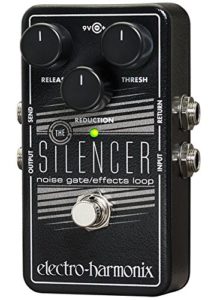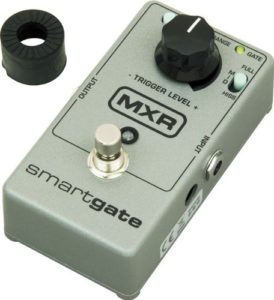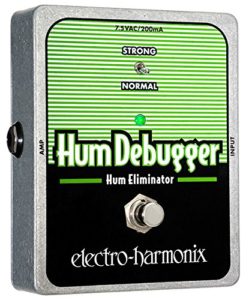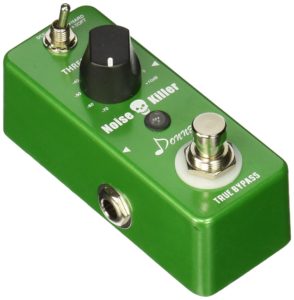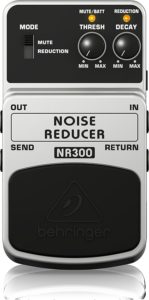What’s the best noise gate pedal? We know the right answer.
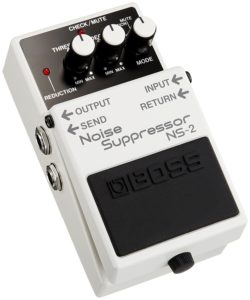
The word ‘gate’ in noise gate is used quite literally. A noise gate pedal lets some signal through its ‘gate,’ while another less wanted noise is left behind, locked out, and not welcomed through!
Noise gates were initially widely used in the studio when recording music to clear up recorded tracks, which had other sounds bleed through their microphones. Still, guitarists saw an ideal application of the noise gate in cutting out feedback, mains hum, pickup hum, and unwanted hardware noise out of their mix.
Noise-gating is a diverse, dynamic effect, and many pedals exist, which can help us with all sorts of noisy problems. But we first need a basic understanding of noise suppression to sense out the best noise gate and suppression pedals.
Top 6 Best Noise Gate Pedals and Suppressors:
Electro-Harmonix The Silencer Guitar Noise Gate Pedal (Editor’s Choice)
It is another small, compact noise suppression solution from Electro-Harmonix. This pedal features full control over your threshold, the strength of reduction, and the decay of the gate. The pedal can reduce sounds by up to -70dB, and its decay extends to up to 4 seconds. That gives the pedal some creative potential in sculpting unique gated sounds.
It features sends and returns, so like the Boss NS-2. In addition, you can use it in an FX loop to suppress both your guitar and your FX pedal chain. It’s reportedly a pretty seamless suppressor, and some swear by it over other more advanced pedals.
Its appealing artistic design is strong, light has good battery life, and the pedal does the job for a markedly lower price than some of its competitors.
Pros
- Some swear by this pedal
- Adaptable, small, and rugged
Cons
- Can produce artifacts when subjected to more complex noise
Boss NS-2 Noise Suppressor Pedal
The Boss NS-2 comes in Boss’ familiar footprint, with a decay control, threshold control, and mute and reduction settings. With these settings, the NS-2 is one of the more versatile listed pedals in this review. In addition, its threshold control acts with the decay control to provide effective gating.
The decay can be high or low, with a quick decay, meaning sounds are audibly cut off as they dip under the threshold. A slow decay is more suitable for tones with more sustain. With quick decays, you can create effective creative gating effects that stutter your playing.
It has two modes, mute, and reduction. The mute model cuts all noise from your guitar for when you’re tuning and making adjustments.
Reduction puts the pedal in gate mode. The pedal has intelligent circuitry, which preserves your dynamics when you play while acting on problem zones most associated with unwanted noise.
The Boss NS-2 is reliable and is a ubiquitous noise suppression pedal that crops up everywhere as hard-wearing, useful, and effective. It pairs very well with Boss’ distortion pedals and can tighten up your sounds when you’re playing in a high-gain environment using loud rigs and set-ups.
The Boss has sent and returns, too, meaning you can use it in your FX loop. This means you can have the gate in-line between your guitar and the amp and in-line on your FX loop so you can suppress noise from your guitar and your FX pedals simultaneously.
Pros
- Tried and tested pedal that has survived the test of time
- All the settings you need for adaptable use
- You can use it in an FX loop
Cons
- One of the most expensive pedals
MXR M-135 Smart Gate Noise Gate Pedal
The MXR M-135 is a smart pedal, meaning it uses adaptive technology to suppress frequencies associated with the types of noise you can select on the pedal. These 3 types are ‘hiss’, ‘hum’ and ‘full’. The pedal is called a gate, however, so how does it act differently?
It has a controllable threshold. At lower thresholds, the pedal acts in a more subtle way to clear up selected noise.
At higher thresholds, the gate is far less transparent and audibly clamps down on noise. Still, the pedal reportedly operates with a lot of transparency whatever settings are used, and it’s held in high regard as a set-and-forget pedal that cleans up noise from low mains shielding, hot pickups, etc.
Its three settings give it specific adaptability for its position in your pedal rig, and it can clamp down on noise to that your set-up falls victim to.
It’s a sturdy design that is sure to withstand getting thrashed on the road. Users recommend using a 9V power supply, though, as it can run a bit slow on the battery.
Pros
- Smart and intuitive with selectable types of reduction
- Threshold control
Cons
- 9V supply recommended
Electro-Harmonix Hum Debugger
Labeled as neither a gate nor a suppressor, Electro-Harmonix claim the hum debugger is an intelligent remover of guitar hum.
Its design is super simple, with ‘strong’ or ‘normal’ settings that control the hum’s attenuation. ‘Normal’ acts mainly on a 60hz hum, which is associated with pickups. ‘Strong’ acts on humming frequencies outside of this range. It features a simple on-off switch, and there are no setting issues with this pedal.
Its performance does, however, receive mixed reviews. On the whole, users report that it acts on specific frequencies intelligently on normal mode, cutting them out of your tone without interfering with the rest of the signal.
It seems most at home when filtering out noise from pickups, though, in opposition to heavier duty gating, we need to filter unwanted noise from very loud rigs and pedalboards. In addition, when used as a suppressor in a loud, harmonically dense tone, the Hum Debugger tends to cause some digital artifacts.
Pros
- A simple solution for basic types of hum
- Easily controllable attenuation character using ‘strong’ or ‘normal.’
Cons
- Falls down when subjected to intenser, noisier tones
Donner Noise Killer Guitar Noise Gate Suppressor Effect Pedal
It is the cheapest pedal in the review by a mile, at about $40 and below!
First up, it’s tiny! But how? It doesn’t compromise noise reduction technology at all, but it compromises that you can’t run this with a battery and have to use a 9V supply. That aside, you have a top-grade suppression pedal for $40, which is very effective at ridding your tone of that nasty hum and noise.
It has the expected controls; threshold, gain reduction level, and a true-bypass on and off switch, which doesn’t affect your tone when the pedal is disengaged.
It comes in an appealingly small package, rock-solid, and barely takes up any room in your pedal case. The Donner is a relatively new build pedal, so it packs some modern technology, and users unanimously agree that it tends to get the job done. If you want to see if a noise suppression pedal fits into your rig, then it’s the perfect budget choice for experimentation.
Pros
- Cheap
- Simple
- Durable
Cons
- No battery, only external power supply
Behringer Noise Reducer NR300
Behringer proved that in the 21st century, noise reduction technology should be cheap and functional with their NR300 pedal, which weighs in at $40. Its control set is simple, with threshold and decay settings and a real mute switch. It’s designed to clamp down on noisy, hot single-coil pickups and unwanted hum while preserving your tone, and at a price, it does a damn good job with minimal fuss and expenditure.
Behringer as a brand receives mixed reviews, but one unarguable thing is that their products tend to work very well at their cheaper price points, and the NR300 is no exception. Users report that it ‘just works,’ canceling out fizz from distortion pedals, whiny hiss from pickups, mains hum from poorly shielded components, the lot!
Its housing is lightweight, and its settings can’t be messed up. It’s easy to dial in settings, set, and forget. Some users say that in extremer circumstances, it can suck out some of your guitar tones, but for those experimenting with distortion and gates, or for those who want a quick, cheap solution for noise suppression, the NR300 should be your first port-of-call.
Pros
- A cheap pedal that works well in reducing simple noise
Cons
- Can suck guitar tone when subjected to more aggressive settings
Buyer’s Guide: How to Select the Best Noise Gate Pedal
Why Do Guitarists Need Noise Gates?
High volume, high energy, high gain guitar playing means lots and lots of NOISE! In this scenario, it sounds like hum from your pickups, when amplified, can sound nasty. When you combine this hum with distortion, you can quickly create an unsavory level of unwanted noise.
Guitars really can be boisterous! You have the sound of the strings, the pickups, and their associated hum, distortion, amp FX, and other outboard FX all building up to create a massive sound suitable for heavier styles. Gates help us control this awful stuff, so the excellent noise shines through!
How Does It Work?
The way a gate works is by opening up when a signal passes through which exceeds your threshold. For example, a hum maybe a reasonably low volume. However, it’s still loud enough to clog your tone up and detract from your playing. Therefore, we can set our threshold with a gate, so any noise exceeding this hum’s volume is allowed through. The rest is cut out.
Think of a snare drum mic positioned close to a hi-hat. The snare is by far the strongest signal. But you can still hear a faint, unpleasant chatter of a hi-hat in the background.
You can eliminate this faint background noise by gating, meaning that the gate allows the snare drum’s strong signal through but cuts out the unwanted hi-hat in the background. That leaves us with a tighter sound.
The Most Important Settings
Threshold
That governs how high our signal must be for it to come through our gate. A low threshold will mean that it will cut out only the quietest sounds. That is more suitable for subtle hums and noise.
Attack
That governs how aggressively your gate will trigger. For example, a quick attack is generally used in guitar playing, which means the gate quickly acts on sounds that surpass your threshold, opening up and letting them through. In addition, most pedals have automatic attack settings, so they open in a way that best suits the input.
Release/Decay
That governs how long the gate is open. A quick-release will mean that notes are cut off quickly after the signal drops below the threshold. That creates a staccato effect.
A more extended-release or decay will mean that your gate allows more sound through after it’s been triggered by a signal that surpasses the threshold. That means it rolls off more smoothly.
A lot of pedals have automated release settings that adjust based on the input. So, for example, they will decay slower if they detect a chord with a long sustain.
Why Do We Need A Noise Gate In Pedal Form?
We have this effect available in a pedal to choose when we want to engage our gate. Some guitar parts suit a buzzy, noisy amp that rings out between playing, or maybe at the end of a show, a long ringing out of feedback and distortion has the climactic effect you want.
With a noise gate pedal, you can disengage the gate and leave your tone unaffected. These pedals can go at the end or the start of your chain. Sometimes two pedals are used. A suppressor goes before your amp, and after any FX pedals, a gate goes after your guitar and in your FX loop if you have one.
A suppressor may go immediately after your guitar if you want to suppress pickup hum when used alone. However, if you want it to act on noise created by your other pedals, too, it must go after these in your chain. Experiment!
Noise Gates As Creative FX
Noise gates aren’t just for reducing unwanted sound. You can use them creatively to create stuttery effects that match the rhythm of your playing. Many of Buckethead’s tones are created using gates in tandem with other FX, creating a stuttered rhythmic effect as the gate opens and closes. For example, say we have a reverb pedal going into a gate. We can enable our reverb and then press our gate pedal. That allows small portions of our reverb through in a rhythmic way we can control with our gate.
Differences Between Suppressors And Gates
When looking at different pedals designed to reduce noise in general, two different types are easily confused.
Gates
These completely cut sounds below the threshold based on your attack, release, or decay settings. These are more aggressive in general and have more creative application.
Suppressors
These act on specific ‘problem’ frequencies, usually using smart, selective technology that filters out frequencies associated with humming and poor mains shielding. These are more of a utility pedal than a creative one.
Manufacturers often combine these two types. Your requirements will broadly fit into one of these two categories, though. Below we discuss the best noise gate pedals for guitarists.
Conclusion: The Best Noise Gate Pedal?
Gates and suppressors vary a lot for tools designed with one outcome in mind; reducing unwanted noise. Many people find that some pedals do not suit their rig at all, where others work perfectly.
Experimentation with different types of reducers is a must. Your choice depends mostly on how heavy-duty your required noise suppression needs to be.
In very high-gain, high distortion situations, the more expensive models in this line-up may help you achieve a reduction of hiss, hum, fizz, and other artifacts introduced by FX pedals.
For those who want to use a gate in their FX loop and in-line from guitar to amp, The Silencer by Electro-Harmonix and the Boss NS-2 should be most suitable.
For those looking for a basic reduction of pickup hum, the simpler models should suffice. However, for those just starting with pedalboards, distortion, and FX, the cheaper models effectively reduce a fraction of the more expensive pedals’ price.
